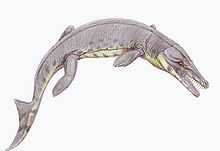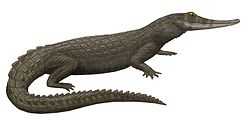Shamosuchus
| Shamosuchus Temporal range: Late Cretaceous, 85–66Ma | |
|---|---|
| | |
| Holotype specimen | |
| Scientific classification | |
| Kingdom: | Animalia |
| Phylum: | Chordata |
| Class: | Reptilia |
| Superorder: | Crocodylomorpha |
| Family: | †Paralligatoridae Konzhukova, 1954 |
| Genus: | †Shamosuchus Mook, 1924 |
| Species | |
| |
| Synonyms | |
| |
Shamosuchus is an extinct genus of neosuchian crocodile that lived during the Late Cretaceous (Santonian-Maastrichtian) period in what is now the Gobi desert of Mongolia, approximately 85 to 66 million years ago. The teeth were adapted to crush bivalves, gastropods and other animals with a shell or exoskeleton . The genus was named in 1924 by Charles C. Mook.[1]

Most of the information on this genus comes from the type species S. djadochtaensis, including a well preserved skull. The eye and nasal openings were not raised above the skull as in modern crocodilians, so that the animal would have to raise its head completely out of the water to breathe . As this cranial morphology does not suit an ambush predator, it lends support to the idea of a diet of aquatic invertebrates.
The genus Paralligator, named in 1954, was synonymized with Shamosuchus in 1983.[2][3] Several species of Paralligator, including P. gradilifrons and P. sungaricus, have been reassigned as species of Shamosuchus.[2][4][5] "P". sungaricus is known from the Early Cretaceous Nenjiang Formation in Jilin Province, China.[6][7]
References
- ↑ Mook, C. C. (1924). "A new crocodilian from Mongolia". American Museum Novitates 117: 1–5.
- ↑ 2.0 2.1 Konzhukova, E. D. (1954). "Newly discovered crocodiles from Mongolia". Transactions of the Institute of Palaeozoology, USSR Academy of Sciences 48: 171–194.
- ↑ Efimov, M. B. (1983). "Review of fossil crocodiles of Mongolia". Transactions of the Joint Soviet–Mongolia Paleontological Expedition 24: 76–95.
- ↑ Rozhdestvenskiy, A. K. (1974). "History of the dinosaur fauna of Asia and other continents and questions concerning paleogeography". Transactions of the Joint Soviet–Mongolia Paleontological Expedition 1: 107–131.
- ↑ Storrs, G. W.; Efimov, M. B. (2000). "Mesozoic crocodyliforms of north-central Eurasia". In Michael J. Benton, Mikhail A. Shishkin, David M. Unwin, Evgenii N. Kurochkin (eds.). The Age of Dinosaurs in Russia and Mongolia. Cambridge University Press. pp. 402–419.
- ↑ Sun, A.-L. (1958). "A new species of Paralligator from Sungarian Plain.". Vertebrata PalAsiatica 2 (4): 277–280.
- ↑ Wu, X.-C.; Cheng, Z.-W.; Russell, A. P. (2001). "Cranial anatomy of a new crocodyliform (Archosauria: Crocodylomorpha) from the Lower Cretaceous of Song-Liao Plain, northeastern China". Canadian Journal of Earth Sciences 38: 1653–1663. doi:10.1139/cjes-38-12-1653.
External links
- CRETÁCEO répteis e anfíbios
- Paralligatoridae
- Répteis Crocodilianos
- Shamosuchus drawing
- Forum on ancient species K-T crocodylians
| ||||||||||||||||||||||||||||||||||||||||||||||||||||||||||||||||||||||||||||||||||||||||||||||||||||||||||

